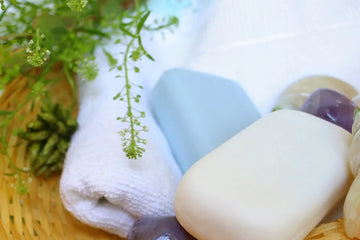Some kind of slime with cleaning benefits was discovered after water (likely rain) mixed with ashes and combined with animal fat leftovers about 4500 years ago (see this cool article from Time magazine https://time.com/5831828/soap-origins/). A reaction between the acidic animal fat and alkaline wood ashes in water caused a primitive cleaning mush to form. Rendered animal fat and processed wood ashes were used (and still are) to make soap in many places.
As the soap making process evolved, vegetable fats or animal fats were combined with lye to make a less slimy, more solid hunk of what we call soap to form. When World War I began, soap makers ran into a supply shortage of animal and vegetable fats. This factor was one of many which influenced the development of synthetic detergents, of which the first was developed in Germany in 1917. By the 1930s, other surfactants were developed (see Dreft history) and by the 1940s these “syndets” (synthetic detergents) were used by large-scale manufacturers of laundry detergents. In 1955 Zest launched (see link -I grew up with "Zestfully Clean!") and beauty bars were readily adopted by the public.
Soon syndets became more popular than real soap.
If you read "Got Soap?" you may have discovered that you're using a "beauty" bar or a "deoderant bar" instead of soap.
Ingredients of one of the best-selling “beauty” bars in the U.S.
(I added a description after the dash to explain its function):
- *Sodium Lauroyl Isethionate—synthetic detergent
- *Stearic Acid—a synthetic additive to harden
- Sodium Tallowate And/Or Sodium Palmate—surfactants derived from animal fat and/or palm oil
- Sodium Stearate—thickener and emulsifier often derived from palm oil
- Water—yep.
- Sodium Isethionate—an organic salt that has skin/hair conditioning effects
- Lauric Acid—fatty acid, most present in coconut oil
- Sodium Cocoate And/Or Sodium Palm Kernelate,
- Sodium C12 14 Olefin Sulfonate—cleansing agent, surfactant
- Fragrance—generally a formulated scent
- Sodium Sulfate—helps with soap solubility
- Propylene Glycol—absorbs water, found in anti-freeze
- Sodium Chloride-salt
- Dipropylene Glycol—decreases viscosity making the soap more spreadable on skin
- Tetrasodium Edta—a chelating agent that helps make hard water soft and decreases residue
- *Tetrasodium Etidronate—same as above, and acts as a stabilizer.
- Blue 1 Lake (Ci 42090)—colorant
- Titanium Dioxide—lightens the color of the soap
- Yellow 5 Lake—colorant. They really want it to be attractive!
*For a deeper dive into these ingredients:
- Sodium Lauroyl Isethionate—a detergent, some studies on how it affects skin can be found here: https://pubmed.ncbi.nlm.nih.gov/10385334/
- Stearic Acid; a fatty acid from animal and plant sources https://www.britannica.com/science/stearic-acid
- Tetrasodium Etidronate https://incibeauty.com/en/ingredients/21558-tetrasodium-etidronate
- For the rest, the Enivronmental Working Group has a good list of ingredients to avoid in different products, including bar soaps https://www.ewg.org/skindeep/contents/top-tips/
Want an ingredient list you can pronounce?
Blue Heron Classic bars: The saponified oils of coconut, olive, rice bran, palm, apricot kernel, castor. Either essential oil/s or fragrance oil/s are added for scent and other benefits.
Eco bars: The saponified oils of coconut, olive,rice bran, apricot kernel, castor and shea butter. Essential oil/s are added for scent and other benefits. Eco bars are zero waste, and palm free.


